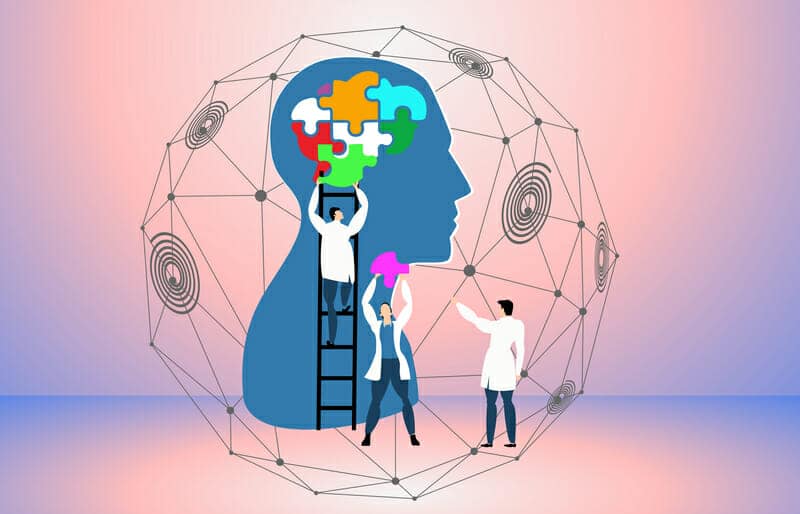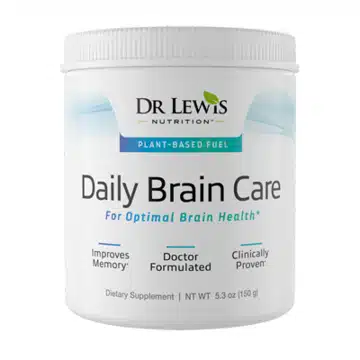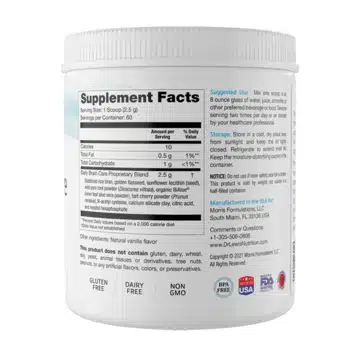Our most precious asset is arguably the grey matter between our two ears.
We need a fully optimized brain at all ages to make smart decisions, handle adversity, and avoid self-sabotaging mistakes that set us back.
But neurodegenerative diseases such as Alzheimer’s rob us — and our loved ones — of years of our lifespan and our overall mental well-being.
So how can we meaningfully reverse the damage done by such diseases, if not prevent it from happening altogether?
My good friend Dr. John Lewis, a former podcast guest, has the answer in the form of a highly-effective nutritional product that supports brain health.
With over 180 peer-reviewed scientific publications under his belt, decades deep in the trenches of modern academia, and millions of dollars raised in grants…
… he may have finally figured out how to help people regain the cognitive functioning they should have never lost in the first place.
This article will talk about the rising Alzheimer’s crisis fueled by the pandemic, and how his Daily Brain Care supplement has been helping afflicted patients over the past decade.
Table of Contents
ToggleWhat Is Neurodegeneration?

Neurodegeneration has multiple working definitions, but this one is the easiest to understand:
“a type of disease in which cells of the central nervous system stop working or die. Neurodegenerative disorders usually get worse over time and have no cure.
They may be genetic or be caused by a tumor or stroke. Neurodegenerative disorders also occur in people who drink large amounts of alcohol or are exposed to certain viruses or toxins”
What you have is the progressive degeneration via lost function — and the eventual death — of nerve cells (neurons) over time.
Where neurodegeneration truly gets dangerous is that it’s not only limited to loss of cognitive functions such as memory, attention, information processing, and basic executive functions such as reasoning and problem-solving.
It can also extend to things such as sensation, strength, coordination, and mobility.
There are numerous risk factors, with older age being one of the highest.
Not only are we witnessing a very sharp rise in the prevalence of neurodegenerative disease, but their burden on our healthcare system is growing right alongside it.
Just take a look at some of the statistics for various examples of cognition-impairing diseases that go far beyond Alzheimer’s and Parkinson’s…
ADD/ADHD
- Almost 10% of children ages 3-17 in the USA are diagnosed with ADD/ADHD, with diagnoses rising by 30% over the past 8 years
- The 2018-2019 calendar year saw a societal/economic cost of ADD/ADHD that amounts to $12.76 billion in the USA alone
- Growing evidence (here and here) suggests a link between ADD/ADHD history and a higher risk for contracting a neurodegenerative disease
Traumatic Brain Injury (TBI)
- TBI is believed to affect 1.5 million Americans every year
- It is estimated that TBI costs our society $76.5 billion annually, both directly and indirectly
- TBI, in addition to presenting its own laundry list of cognitive deficits, is also becoming more well-known as a major risk factor for the development of neurodegenerative disease (see here and here)
Major Depressive Disorder (MDD)
- MDD diagnoses in America reached 17.5 million for the year 2018 alone, and globally we observed a 27.6% increase in MDD prevalence as a result of the COVID-19 pandemic
- Between 2010 and 2018, the economic burden of MDD-afflicted adults jumped from $236 billion to $326 billion (a 37.9% jump!)
- Although we can’t say for sure that MDD causes neurodegeneration, there is a very strong relationship between having MDD and later contracting a neurodegenerative disease (here and here)
The buck doesn’t stop there — athletes experiencing concussion syndrome, alcohol addicts, and other people suffering from cognitive difficulties are simultaneously rising in numbersm, costing us more in healthcare expenses, and robbing us of billions in lost work productivity.
Cumulatively, neurological diseases already cost us $800 billion in 2017 and they’re well on their way to costing us over $1 trillion annually… if not $1 trillion for every INDIVIDUAL neurodegenerative disorder.
Add on a rapidly aging population and you have the perfect formula for a medical apocalypse.
Why Is Alzheimer’s Disease The Worst Form Of Neurodegeneration?
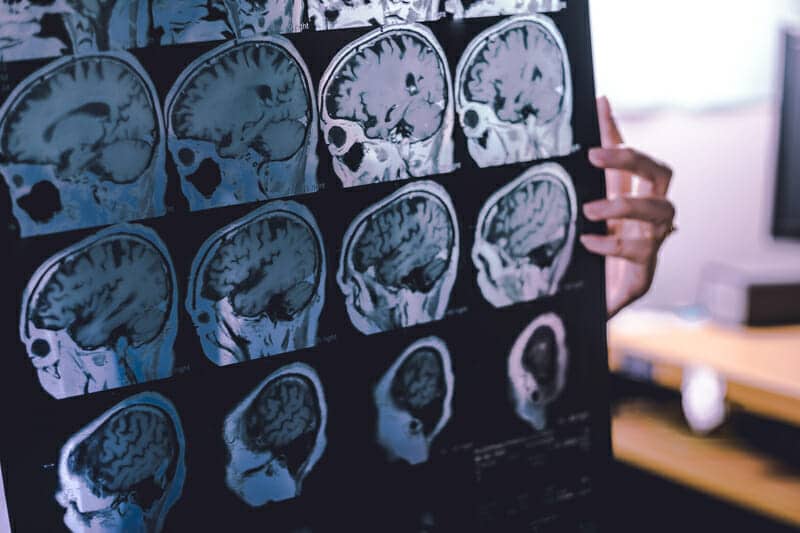
First, a quick overview of Alzheimer’s Disease so you know what I’m talking about:
“Alzheimer’s disease is a brain disorder that slowly destroys memory and thinking skills and, eventually, the ability to carry out the simplest tasks. In most people with the disease — those with the late-onset type symptoms first appear in their mid-60s”
“[The neurodegeneration] initially takes place in parts of the brain involved in memory, including the entorhinal cortex and hippocampus. It later affects areas in the cerebral cortex, such as those responsible for language, reasoning, and social behavior. Eventually, many other areas of the brain are damaged”
It’s important to note that while there are many similarities between Alzheimer’s and Parkinson’s, there are some important differences:
“Parkinson’s disease generally begins as a movement disorder… Alzheimer’s disease generally begins as noticeable memory loss”
“Alzheimer’s mainly affects language and memory at the outset, whereas Parkinson’s affects problem-solving, speed of thinking, memory, and mood.
Unlike Alzheimer’s disease, people with Parkinson’s-related dementia often experience hallucinations, delusions, and paranoid thoughts”
When I first spoke to Dr. John Lewis, he described Alzheimer’s Disease as the “HIV/AIDS of the 1980s”.
He shared several shocking data points that show just why it is the most devastating form of neurodegeneration in human existence:
- 6.2 million Americans live with Alzheimer’s Disease in 2021, and it is currently the SIXTH leading cause of death in the United States (Source)
- Worldwide, the prevalence of Alzheimer’s Disease worldwide is projected to triple from 57 million to 153 million by the year 2050 (by 2030, the number will be at 78 million)
- Alzheimer’s Disease cost the US healthcare system $305 billion to treat in 2020 alone, and between 2017-2030 the cumulative cost may be as high as $7.7 trillion
But it gets even worse…
Out of all the top 10 leading causes of death in the United States, Alzheimer’s Disease is the ONLY one that has no cure or preventive measure, nor can be delayed.
(Unlike people who can proudly say “I’m a cancer survivor”, you’ll never hear anybody say “I’m an Alzheimer’s survivor”)
And putting aside the fact Alzheimer’s surpasses every other neurodegenerative disease across every metric, the human cost to the victim and caregiver(s) due to loss, pain, and suffering is immeasurable.
It also doesn’t help that our monomaniacal focus on the COVID-19 pandemic led us to ignore the care Alzheimer’s patients desperately needed, which led to unnecessary excess death and worsening symptoms of cognitive decline.
As much as I want those statistics to be the end of the picture, Dr. John Lewis informed me the tragedy of Alzheimer’s Disease doesn’t end there.
All Previous Treatments For Alzheimer’s Disease Have Failed
For a disease that’s been around since the start of the 20th century, you’d think we would have figured out how to treat it by now.
Unfortunately, this is not the case.
Drug development for Alzheimer’s has failed monumentally with a 99.6% failure rate between 2002-2012 that hasn’t budged an inch.
The most notable example of failure was the drug candidate Dimebon developed by Pfizer and biotech firm Medivation, which failed to show significant improvements for Alzheimer’s patients in Phase 3 clinical trials.
As a result of shutting down the project in 2012, Pfizer wrote off $725 million in losses and Medivation had to lay off 20% of its entire workforce.
Six years later, Pfizer announced a massive layoff of 300 people due to “pulling out of early-stage research into Alzheimer’s and Parkinson’s diseases” (Source)
Similar stories of disappointment were also repeated with the pharmaceutical companies Eli Lilly (here and here) and Merck, although the latter is giving it a second shot with a $1 billion investment in August 2022.
Dr. John Lewis summarized the sad state of affairs into a few key points:
- The conventional treatments, at best, delay the decline for a few months before a patient continues their inevitable cognitive decline and/or develops some form of resistance to the medication they’re receiving
- Not only is the amelioration of symptoms minor at best, but toxic side effects of the medications they receive and the risks of co-morbid complications add to the lack of efficacy.
All of this is a way to say we don’t have any cure of Alzheimer’s Disease at the time of writing.
Which can probably be explained in large part by the next tragic reality of the disease…
We Still Don’t Fully Understand Alzheimer’s Disease
Scientists don’t have a consensus agreement on what even causes Alzheimer’s, let alone how to prevent it or how to treat it, or how to give the family member(s) instructions on what to try and whether there’s a chance they will see some improvement.
The science behind this is incredibly complex and there are multiple theories of the cause and progression of Alzheimer’s, so let me dumb this down as much as possible…
One dominant theory is the buildup of amyloid plaques:
“Plaques form when protein pieces called beta-amyloid clump together. Beta-amyloid comes from a larger protein found in the fatty membrane surrounding nerve cells.”
“The small clumps may block cell-to-cell signaling at synapses. They may also activate immune system cells that trigger inflammation and devour disabled cells.”
These plaques cannot be dissolved and broken down by the body for removal, which means they accumulate over time and distribute themselves in different regions of the brain.
The second dominant theory is the accumulation of neurofibrillary tangles:
“…neurofibrillary tangles are found inside the brain cells. In healthy cells, microtubules are involved in the transport of material inside cells. Tau is a protein that works with microtubules in this transport system. In Alzheimer’s disease, tau is severely altered and begins to clump together to form tangles. As a consequence, there is an impairment of the transport system that eventually contributes to the death of the cell.”
The only problem is that the presence of these two things — one of them or both of them — does not necessarily mean someone will develop symptoms of Alzheimer’s at all.
This is especially true for the amyloid plaque buildup theory, where factors such as genetic links can play a role in developing Alzheimer’s independently of the presence of plaque.
I’m not even going to get into the Summer 2022 scandal surrounding the plaque hypothesis.
I highly encourage you to read here and here for the full details, but the one-sentence summary is this:
Several published high-profile papers of an influential researcher promoting the amyloid plaque hypothesis are allegedly based on fake and doctored images.
Which means you effectively have three groups of Alzheimer’s patients:
- The group of people who have the clinical pathological profile and have Alzheimer’s Disease
- The group of people who have the clinical pathological profile but DO NOT have Alzheimer’s Disease
- The group of people who DO NOT have the clinical pathological profile, YET they still have Alzheimer’s Disease
As Dr. John Lewis told me, “every time you meet someone with Alzheimer’s is effectively your first case because each patient’s circumstances are so unique it’s difficult to classify people with this disease globally”
And even with something like the “ε4” variation of the APOE gene coding for apoE (apolipoprotein E protein) increasing your risk of Alzheimer’s, it doesn’t necessarily mean you’ll get Alzheimer’s.
But John’s approach is entirely separate from the majority of academia.
He recognizes the importance of understanding post-mortem pathologies and risk based on family history.
His work focuses on helping people who are afflicted with the disease, while also demonstrating the health benefits of nutrition in terms of possibly preventing Alzheimer’s altogether.
Why Nutrition Is The Hidden Key To Solving The Puzzle Of Alzheimer’s Disease

The conventional standard of care for Alzheimer’s includes physical therapy, surgery, medication, and intentional socialization… but nutrition is never brought up 99.9% of the time.
And it’s absolutely ludicrous.
Anybody who has read my articles or podcasts on nutrition will know how fundamental I consider it to be for fully optimized health.
Past oxygen and water, there is nothing more important than what we CHOOSE to put in our mouths.
Whether it’s Alzheimer’s or a broken bone, whether a condition involves acute or chronic damage, the body still requires the right sustenance to give it the best possible chance to heal itself.
We need vitamins, minerals, metabolites, bionutrients, and other elements that our body needs but can’t synthesize on its own such as essential fatty acids.
The phrase “you are what you eat” is so true because everything we shove down our throats acts as “information” for our cells.
If you remember what I just said about having a genetic predisposition to Alzheimer’s, the flipside is that genes do not do anything until they receive information from the environment that contain instructions which then dictate to your cells how they should function.
In other words, EPI-GENETICS is/are the ultimate determinant.
This is why it’s so important to get over the psychological reward for chasing the good feeling of tasty foods.
Instead, we need to ignore this common paradigm and recognize what we consume is the best way to ensure the genetics we’ve been given work in our favor.
And Dr. John Lewis has honed his nutrition-focused approach to Alzheimer’s by doubling down on long chains of carbohydrate molecules known as “polysaccharides” (i.e. sugars):
“Polysaccharides are naturally and synthetically active macromolecular substances formed by more than ten monosaccharides connected by glycosidic bonds. Natural polysaccharides are widely present in plants, animals, algae, and microorganisms.
The polysaccharides are regarded as potential useful agent for the prevention of neuronal damage, and have received considerable attention for wide-ranging bioactivity.
Polysaccharides have other beneficial properties including biodegradability, high stability and low toxicity, solubility in water, higher degrees of swelling capability, etc. Moreover, polysaccharide nanoparticles improve the bioavailability and bioactivity of functional ingredients”
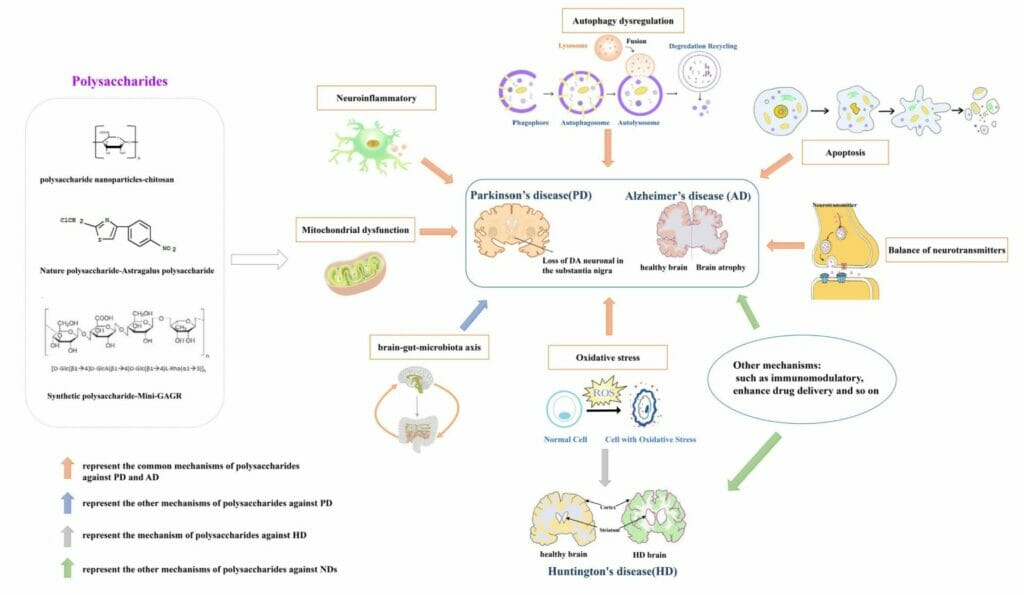
(Source)
Just like fatty acids, we don’t get enough of these naturally-derived polysaccharides in our modern diets as society has changed how food is produced.
But if we take them in concentrated amounts through a dietary supplement, there are multiple plausible mechanisms through which we can activate cellular function.

(Source)
This has a trickle-up effect where the beneficial effects transfer to segments to cells, up to organs, then to an entire organ system, and then through all the biological systems linking together to create us.
What we’re doing here is giving our body the key nutrients to enable the bioengineering of life in every cell, thus allowing the body to naturally repair, heal, restore, and regenerate itself.
If you want to read up more on the untapped potential of polysaccharides for better health, Dr. John Lewis wrote two extensive write-ups worth reading (here and here).
Daily Brain Care: The Long-Awaited, Nutrition-Focused Approach To Neurodegeneration
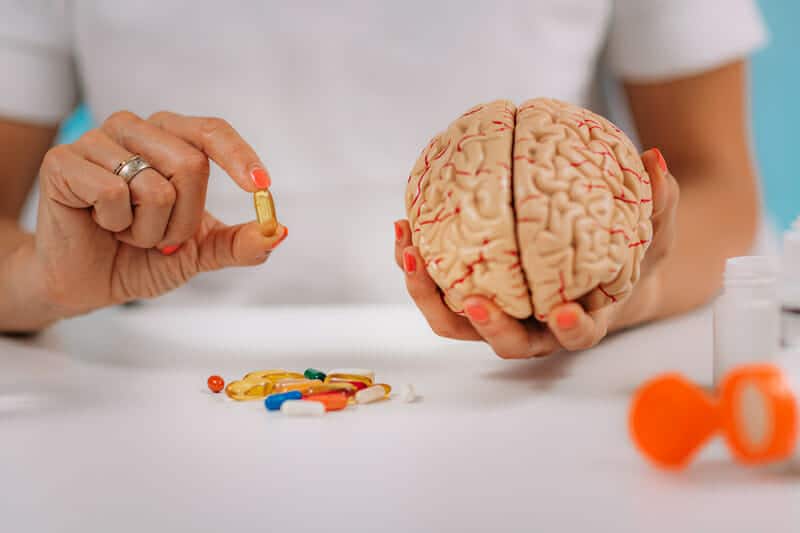
Thanks to 25 years of clinical research and an extensive track record of publishing high-quality research, Dr. John Lewis was finally able to create a cost-effective proprietary trade formula for optimized brain health that is available to the public.
The end result is Daily Brain Care:
Daily Brain Care contains a unique complex consisting of hundreds of fatty acids, amino acids, elements, metabolites, cofactors, vitamins, and polysaccharides.
Most notably, the formula focuses on two powerful polysaccharides that have been extensively studied ina animals and humans:
- BioBran (a hydrolyzed rice brain)
- BiAloe (an aloe polymannose)
Other all-natural ingredients in this formulation include:
- Stabilized rice bran
- Larch tree fiber
- Larch tree soluble extract,
- Cysteine, soy lecithin
- UltraTerra® calcium alumino silicate
- Cherry tart powder
- Inositol hexaphosphate
- Dioscorea (yam) powder
- Omega 3 spherules
- Citric acid
- Glucosamine
Every ingredient is highly concentrated and fully bioavailable to enable the bioengineering of life in every cell.
And as you’re about to see, this dietary supplement documents unparalleled effects not discovered or duplicated by other compounds tested for Alzheimer’s Disease.
Cognitive Improvement
The benchmark study demonstrating Daily Brain Care’s restorative effects on cognitive functioning was published by Dr. John Lewis and his colleagues in 2013.
The 34 patients enrolled were just under 80 years of age on average, had to be diagnosed with Alzheimer’s for at least one year, and the Alzheimer’s had to be moderate to severe in nature (they did also have other comorbidities such as heart disease and diabetes).
For 12 straight months, the ONLY change these patients made was taking 1 teaspoon orally of Daily Brain Care four times per day.
No changes to influential factors such as behavioral therapy, diet, or exercise were made.
Changes in cognition were assessed using the Alzheimer’s Disease Assessment Scale-cognitive score (ADAS-cog), the gold standard of conducting cognition assessment in dementia studies.
The results demonstrated clinically and statistically significant improvements — something completely unheard of in the scientific community as no pharmaceutical drug or nutritional product has come close to achieving.
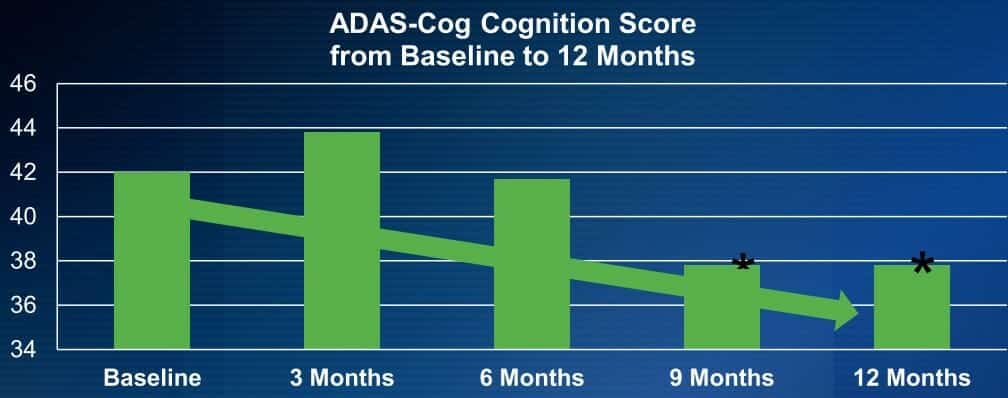
To interpret the graph above correctly, a decrease in the ADAS-Cog score means the patient’s cognitive function improved.
(NOTE: The slight bump in the score at the 3-month mark is not significantly significant, and any change is only clinically meaningful when it is more than 4 points)
If there’s anything to take away from this study, it’s that nutrition takes time to work as we are dealing with very sick and impaired people.
However, there will always be the “super-responders” who already start to feel better within a few days.
I recommend reading Dr. John Lewis’ informal write-up of the study, particularly paying attention to the paragraph below:
“We did NOT treat, cure, manage, or mitigate disease, but we showed the ability of the body to repair and regenerate itself when given the proper raw materials (i.e., nutrients) to do so.
…Given the body’s innate intelligence, it can utilize important nutrients, particularly these important polysaccharides (sugars), to repair the damage that a lifetime of poor diet, lack of exercise, and chronic inflammation can cause.”
Lowered Inflammation
In the same 2013 study I just mentioned, there was a notable improvement in chronic inflammation through the lowering of the key markers VEGF and TNF-alpha at the end of the 12-month trial period.

Some more intel on both inflammatory markers from the study:
“TNF-alpha and other cytokines have been shown to be elevated in the cerebrospinal fluid and plasma of persons with AD [Alzheimer’s Disease] compared to controls, but the findings are not unequivocal as other studies show no differences. Nonetheless, anti-TNF-alpha therapy has been posited as a way to prevent or decrease the effects of neuroinflammation and perhaps cognitive disorders”
“Others have suggested that VEGF might be linked to the progression of AD through abnormal endothelial activation, resulting in neuronal loss and Aβ deposits… Our higher VEGF concentration at baseline may also support the hypothesis that VEGF lacks a neuroprotective effect among neurodegenerative disorders”
There was also a reduction in the proinflammatory cytokine IL-1β, which is a fancy way of saying it’s a sign of reduced neuroinflammation.
Improved Immunity
I want to re-visit the 2013 study as it turns out Dr. John Lewis did a very extensive biomarker panel for all the clinical trial patients that went above and beyond assessing cognition.
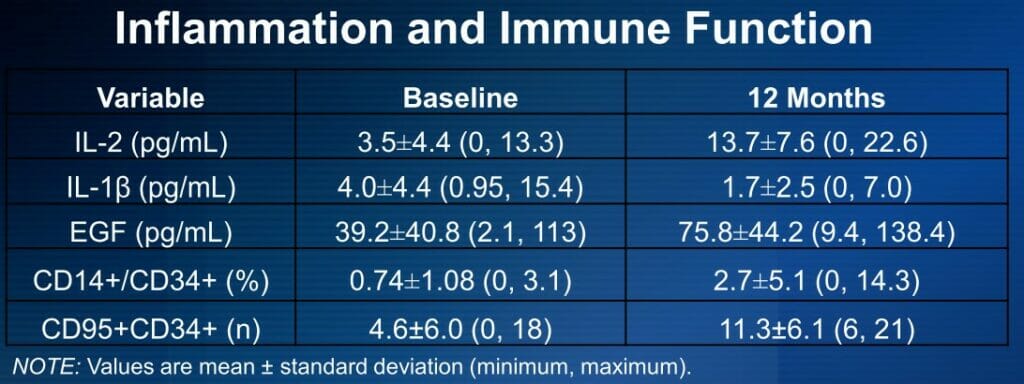
Dr. Lewis told me how to interpret the results above:
“CD95 (Fas antigen) is a cell surface receptor that plays a key role in regulating immune responses and counteracting autoimmune dysfunction. A greater level of EGF is an important new discovery showing that enhanced nutrition may improve remyelination, which is a significant pathological feature of this disease.”
“Polysaccharides lower inflammation and drive the immune system to proliferate adult stem cells, which migrate to the brain and improve cognitive functioning.”
But in addition to this, Dr. Lewis also published a clinical trial in 2019 where he tested Daily Brain Care on patients with Multiple Sclerosis to see how it would impact their immune system.
This was a much smaller study involving 8 male and 7 female patients with an average age of 51.3 years.
To the surprise of Dr. Lewis and his team, the total number of infections went down after 12 months of using Daily Brain Care three times a day:
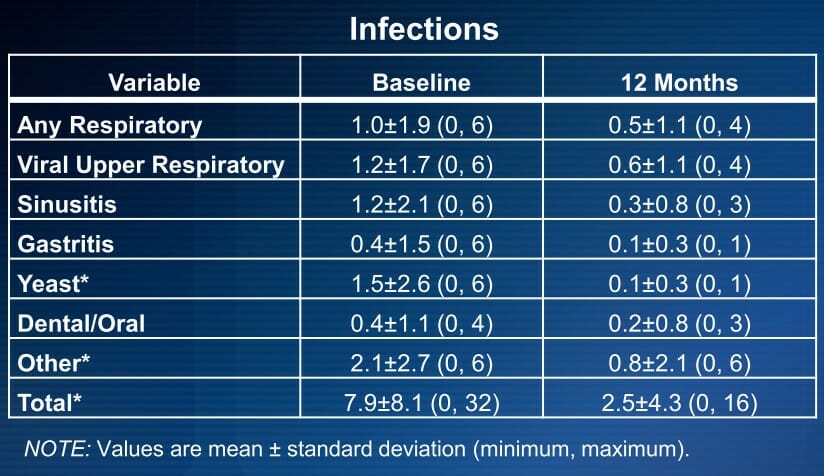
These findings are significant as infectoins are the leading cause of mortality in this patient population and a common cause of morbidity.
The worst side effect reported was a mild gastrointestinal intolerance that only appeared in four patients.
Clearly, we have something on our hands that supports optimal brain health AND immune health.
Elevated BDNF Production
If you already read my deep dive article on brain-derived neurotrophic factor (BDNF), you know this growth factor is critical for the creation of new neurons, new connections between neurons, and strengthening connections between neurons.
Dr. John Lewis first looked into the possible connection between BDNF and Alzheimer’s Disease using his Daily Brain Care regimen in 2017.
And while BDNF levels did not improve significantly after 12 months, his other finding was even more interesting:
“The current findings suggest a potential mechanism involving BDNF that may contribute to improved cognitive functioning.
Additionally, we showed at baseline that those at BDNF <5000 pg/mL performed worse on several of the cognitive assessments than those that were BDNF >5000 pg/mL. We stratified participants at 5000 pg/mL because our prior findings suggested that this threshold distinguishes cognitive functioning to some degree in persons with HIV.
As noted in the current study, cognitive performance was better in the group at 5000 pg/mL or higher for the MMSE, every ADAS-cog scale, and all SIB scores, except for the SIB total score”
(NOTE: The last line is a way of saying that higher BDNF levels was connected with better cognitive functioning regardless of which evaluation method they used to assess cognition)
Then, in 2019, Dr. Lewis conducted a similar study except he wanted to see if the relationship between BDNF and cognitive function could also extend to positive benefits for lowering inflammation and improving immunity.
In addition to a modest improvement in BDNF production, the following observations were also noted:
“In AD, CD95+ cells have been implicated in calpain-induced cell damage and neurocognitive decline . Our results [BDNF > 5000 pg/mL associated with lower CD95+] show an additional relationship with BDNF, suggesting that this neurotrophic factor may exert effects through this mechanism.”
Our study also showed an inverse relationship between neutrophils and BDNF. In transgenic AD models, other studies have shown that neutrophil depletion or inhibition of neutrophil trafficking has reduced AD and improved memory in mice, already showing signs of cognitive dysfunction”
This likely explains why Daily Brain Care could be useful for normal individuals AND patients suffering for Alzheimer’s Disease.
Better Quality of Life
In 2020, Dr. Lewis ran a clinical trial with his Daily Brain Care supplement on 15 multiple sclerosis (MS) patients who were afflicted with MS for an average of 12 years.
Just like the pivotal 2013 study demonstrating significant cognitive improvements, this study noted numerous quality-of-life improvements:
“Participants were assessed at baseline and at 3, 6, 9, and 12 months with the following: (1) Functional Assessment of MS (FAMS), (2) the EQ-5D-3L, (3) Beck Depression Inventory-II (BDI), (4) Health Conditions Discomfort Scale (HCDS), and (5) Self-Assessment of Severity of MS Symptoms Scale (SASMSSS)
…At the end of the intervention, participants showed significant improvements in all outcome measures, particularly functionality on the FAMS, overall quality of life on the EQ-5D-3L, fewer depressive symptoms on the BDI, and improved severity of symptoms on the HCDS and the SASMSSS”
But that’s not the main thing I want to highlight.
What I want to direct your attention toward is the video below, taken from Dr. Lewis’ collection of testimonials:
When the filmmakers first saw 83-year-old Dulce (and before she started using Daily Brain Care), she did not get out of her chair or offer to do so.
All she could do was barely squeak out a “hello” and acknowledge there were people in her house.
But after 6 weeks of using Daily Brain Care on a consistent basis, it was like looking at a completely different person.
Dulce was walking throughout the house, serving herself water, playing with her dog, and having a real conversation with the film crew.
Her face and skin were glowing as if new life was breathed into her.
Dulce was a super-responder who is still doing well to this very day, and may potentially be a survivor of Alzheimer’s.
There’s no way to tell if her entire range of cognitive function will be restored, but just the improved quality of life and being able to understand things better are literally life-changing.
Many people who see improvements within 10-12 weeks also report benefits such as happier mood, more refreshing sleep, and improved stomach function.
You can see numerous examples of these improvements in the written reviews for Daily Brain Care.
But beyond the patient, Dr. Lewis wants us to consider how the caregiver benefits from all this
“Caregivers of Alzheimer’s Disease are the most affected caregivers. They get sick themselves because is so unbearably stressful.
It’s not just the patient who is affected, but also their immediate-surrounding caregivers and family.
Seeing functionality change for the better in the daily routine of an Alzheimer’s patient is extremely rewarding to witness”
What You Should Know Before You Take Daily Brain Care
Dr. Lewis wanted me to highlight a few key points from his FAQ page so you know what you’re getting into.
- Some people may experience a “white box effect”, meaning a list of unexpected benefits such as an initial detoxing effect that presents as increased bowel movements yet normalizes quickly
- The majority of people will respond to this product anywhere between a few days to a few months, so please be patient in allowing your body to heal itself
- The recommended dose is one serving at breakfast and one serving at dinner
- Daily Brain care can be safely taken with any other dietary supplement or prescription medication, and no serious adverse reactions/interactions should be expected
- One 150 g tub of Daily Brain Care contains 60 servings and will last a total of 30 days
If you have any further questions, I highly suggest you email Dr. Lewis at [email protected].
The Future Of Daily Brain Care: Escaping The Clutches Of Big Pharma

When Dr. Lewis did his podcast with me in 2019, he left his full-time position in academia to enter the business world.
Although Daily Brain Care wasn’t always his top priority, the extraordinary results from his research convinced him it was time to think on a global scale and help every segment of society.
Teens with ADD/ADHD, athletes suffering from performance issues, elderly people who want to prevent cognitive decline… there was and still is a serious need for an effective solution to deteriorating brain health.
Many people today are suffering from “information overload” and are operating with diminished concentration levels, and their “way out” is taking multiple medications with toxic side effects.
On some level, consumers are waking up.
They’ve recognized that the traditional medical model has failed them in preventing and/or reversing disease, leading them to seek out alternatives in the form of dietary supplements.
But thanks to Dr. Lewis’ exceptional track record in research and development, he finally has something that’s science-backed and efficacious in improving the cognitive health of every human being.
His future steps involve raising more money from investors to fund the new research that must be done to further enhance and solidify the value of Daily Brain Care.
No, you won’t see this supplement being run in Phase 1-3 clinical trials for FDA approval.
This is pure nutrition – Daily Brain Care is composed of 100% all-natural, nothing synthetic or metabolized.
CONCLUSION: What You Put In Your Mouth Matters More Than You Think

The human condition will continue to evolve in the Golden Age, but only if we start from square one and fix the fundamentals.
Yes, this means we have to be grown-up adults and master the ability to put down the fork when needed and only choose the foods that nutritionally support fully optimized health.
But thanks to Daily Brain Care and the tireless work of Dr. Lewis, we have a cutting-edge product for brain health that doesn’t stand on the anonymous testimonials of “dude bros” on Instagram and bodybuilding forums.
We have something clinically proven to work in the people who are most negatively impacted by neurodegenerative disease.
A solution to go beyond the symptoms of disorders like Alzheimer’s and hopefully see a real long-lasting reversal in cognitive decline.
If you or a loved one is in dire need of a change in your brain health, I highly recommend you visit Dr. Lewis’ website and order your bottle of Daily Brain Care today.
It’s an investment you don’t want to wait on until it’s already too late.
As always…
Raise Your Vibration To Optimize Your Love Creation!
PS – If you want direct access to many more under-the-radar physicians who are decades ahead of conventional “sick-care” medicine, join The Fully Optimized Health Private Membership Group.
It’s your greatest opportunity to fully optimize your health and gain total access to me and my network of high-level men and women living their highest and best life.

